Formulas and Calculations
1/127
There's no tags or description
Looks like no tags are added yet.
Name | Mastery | Learn | Test | Matching | Spaced |
|---|
No study sessions yet.
128 Terms
Chapter 1
What is the formula for calculating taxable trading profit?
You are given:
Accounting profit = £100,000
Income exempt from tax = £5,000
Disallowable expenses = £3,000
Accounting depreciation = £4,000
Capital allowances (tax depreciation) = £6,000
Taxable Trading Profit =
Accounting Profit
– Income exempt or taxed elsewhere
Disallowable expenses
Accounting depreciation
– Tax depreciation (capital allowances)
Example:
Accounting profit = £100,000
Exempt income = £5,000
Disallowable expenses = £3,000
Accounting depreciation = £4,000
Capital allowances = £6,000
Taxable trading profit = 100,000 – 5,000 + 3,000 + 4,000 – 6,000 = £96,000
What is the formula for calculating capital gains (chargeable gain)?
What is the formula for calculating a chargeable capital gain?
You are given:
Sale proceeds = £150,000
Selling costs = £5,000
Original cost = £90,000
Purchase costs = £2,000
Enhancement costs = £10,000
Indexation allowance = £3,000
Chargeable Gain =
Proceeds
– Selling costs
– Original cost
– Purchase costs
– Enhancement costs
– Indexation allowance
Example:
Sale proceeds = £150,000
Selling costs = £5,000
Original cost = £90,000
Purchase costs = £2,000
Enhancement = £10,000
Indexation = £3,000
Chargeable gain = 150,000 – 5,000 – 90,000 – 2,000 – 10,000 – 3,000 = £40,000
What is the formula for calculating VAT when the price is exclusive of VAT?
You are given:
Net price = £100
VAT rate = 20%
VAT = Net Price × VAT Rate
Gross Price = Net Price × (1 + VAT Rate)
Example (20% VAT):
Net price = £100
VAT = 100 × 20% = £20
Gross price = 100 + 20 = £120
What is the formula for calculating VAT when the price is inclusive of VAT?
What is the formula for calculating VAT when the price is inclusive of VAT?
You are given:
Gross price = £120
VAT rate = 20%
VAT = (Gross Price × VAT Rate) ÷ (100 + VAT Rate)
Example (20% VAT):
Gross price = £120
VAT = (120 × 20) ÷ 120 = £20
Net price = 120 – 20 = £100
What is the formula for calculating VAT payable or reclaimable?
You are given:
Output VAT = £1,000
Input VAT = £600
VAT Payable = Output VAT – Input VAT
If Output VAT > Input VAT → you owe HMRC
If Input VAT > Output VAT → you reclaim from HMRC
Example 1 (Payable):
Output VAT = £1,000
Input VAT = £600
VAT payable = 1,000 – 600 = £400
Example 2 (Reclaim):
Output VAT = £800
Input VAT = £1,000
Reclaim = 1,000 – 800 = £200
What is the formula for calculating taxable income for employees?
You are given:
Salary = £40,000
Bonus = £2,000
Commission = £1,500
Benefits = £1,000
Subscriptions = £300
Pension contributions = £2,500
Charity donations = £200
Personal allowance = £12,570
Taxable Income =
Salary
Bonus, Commission, Benefits
– Subscriptions (approved)
– Pension contributions
– Charity donations
– Personal allowance
Example:
Salary = £40,000
Bonus = £2,000
Commission = £1,500
Benefits = £1,000
Subscriptions = £300
Pension = £2,500
Donations = £200
Personal allowance = £12,570
Taxable income = 40,000 + 2,000 + 1,500 + 1,000 – 300 – 2,500 – 200 – 12,570 = £28,930
How do the VAT Payments on Account (PoA) work for large businesses?
You are given:
Expected VAT per quarter = £60,000
Interim payment in month 2 = £30,000
Interim payment in month 3 = £30,000
Actual VAT due = £62,000
Make:
2 interim monthly payments (months 2 & 3)
1 balancing payment when submitting the VAT return
Based on previous VAT return averages
Applies if annual VAT liability > £2.3 million
Example:
Expected VAT per quarter = £60,000
Feb interim = £30,000
Mar interim = £30,000
Actual VAT = £62,000
Balancing payment = 62,000 – 60,000 = £2,000
Chapter 2
How do you calculate a balancing allowance for tax purposes?
Given: TWDV = £2,000, Sale proceeds = £1,000
Balancing Allowance = Tax Written Down Value (TWDV) – Sale Proceeds
Example:
Asset cost = £10,000
Capital allowances claimed = £8,000
TWDV = £2,000
Sale proceeds = £1,000
Balancing Allowance = £2,000 – £1,000 = £1,000
How do you calculate a balancing charge for tax purposes?
Given: TWDV = £1,000, Sale proceeds = £2,000
Balancing Charge = Sale Proceeds – Tax Written Down Value (TWDV)
Example:
Asset cost = £10,000
Capital allowances claimed = £9,000
TWDV = £1,000
Sale proceeds = £2,000
Balancing Charge = £2,000 – £1,000 = £1,000
What is the formula to adjust accounting profit to taxable profit?
Given:
Accounting profit = £100,000
Disallowable expenses = £5,000
Depreciation = £8,000
Accounting loss on disposal = £2,000
Accounting profit on disposal = £3,000
Capital allowances = £10,000
Balancing allowance = £1,000
Balancing charge = £2,000**
Taxable Profit =
Accounting Profit
Disallowable Expenses
Depreciation
Accounting Loss on Disposal
– Accounting Profit on Disposal
– Capital Allowances
– Balancing AllowanceBalancing Charge
🧾 Example: Taxable Profit Calculation 📘 Accounting Info:
Accounting profit: £100,000
Disallowable expenses: £5,000 (e.g. client entertainment)
Depreciation: £8,000
Accounting loss on disposal of asset: £2,000
Accounting profit on disposal of another asset: £3,000
Capital allowances claimed: £10,000
Balancing allowance: £1,000
Balancing charge: £2,000
📊 Step-by-step using the formula:
Taxable Profit =
= £100,000
£5,000 (disallowable expenses)
£8,000 (add back depreciation)
£2,000 (add back accounting loss on disposal)
– £3,000 (remove accounting profit on disposal)
– £10,000 (capital allowances)
– £1,000 (balancing allowance)£2,000 (balancing charge)
✅ Final Taxable Profit:
= £103,000
How do you calculate a capital gain for tax purposes?
Given:
Sale proceeds = £50,000
Selling costs = £2,000
Purchase cost = £30,000
Purchase costs = £2,000
Enhancement = £3,000
Indexation = £1,000**
Capital Gain = Net Sale Proceeds – (Original Cost + Costs of Purchase + Enhancement Costs + Indexation Allowance)
Example:
Sale proceeds = £50,000
Selling costs = £2,000 → Net proceeds = £48,000
Purchase cost = £30,000
Purchase costs = £2,000
Enhancement = £3,000
Indexation = £1,000
Capital Gain = £48,000 – (30,000 + 2,000 + 3,000 + 1,000) = £12,000
How is indexation allowance calculated?
Given: Original cost = £10,000, Indexation factor = 0.25
Indexation Allowance = Original Cost × Indexation Factor
Example:
Original cost = £10,000
Indexation factor = 0.25
Indexation allowance = £10,000 × 0.25 = £2,500
How do you calculate taxable capital gain when rollover relief is used and the replacement asset is later sold?
Given:
Deferred gain from old asset = £20,000
New asset bought for = £100,000
Sold 20 years later for = £120,000**
Final Taxable Gain = Sale Price – (Original Cost of Replacement – Deferred Gain)
Example:
Deferred gain from old asset = £20,000
New asset bought for £100,000
Tax base = £100,000 – £20,000 = £80,000
New asset sold for £120,000
Gain = £120,000 – £80,000 = £40,000 (includes deferred + new gain)
Chapter 3
What is the formula for calculating underlying tax on a dividend received from a foreign subsidiary?
Also explain what it represents.
Given:
Tax on profits = £250
Profit after tax = £750
Gross dividend = £750
Underlying Tax Formula
Underlying Tax = (Tax on Profits / Profit After Tax) × Gross Dividend
Example:
Profit before tax = £1,000
Tax on profits = £250
Profit after tax = £750
Gross dividend = £750
Underlying Tax = (250 / 750) × 750 = £250
So, £250 of the dividend represents underlying tax already paid by the foreign subsidiary.
How is withholding tax applied to cross-border payments such as dividends or interest?
Given:
Gross payment (e.g. royalty) = £1,000
Withholding tax rate = 10%
Example:
UK company pays £1,000 dividend to an Indian company
UK imposes 10% withholding tax
Tax withheld = £100
Net payment = £900 (that’s what the Indian company receives)
What’s the adjustment required for transfer pricing of goods and services when the transaction is not at arm’s length?
Given:
Actual transfer price = £5/unit
Arm’s length price = £10/unit
Quantity = 10,000
UK tax rate = 20%
Adjustment: Increase taxable profit to what it would’ve been at market rate.
Example:
Actual transfer price: £5/unit × 10,000 = £50,000
Arm’s length price: £10/unit × 10,000 = £100,000
Difference = £50,000 → Add to taxable profits
If tax rate = 20% → Additional tax = £10,000
How is thin capitalisation adjusted when a loan to a related company is not at arm’s length?
Given:
Interest paid = £1,500,000
Arm’s length interest = £300,000
UK tax rate = 20%
Adjustment: Disallow excessive interest not on commercial terms.
Example:
Loan: £10m at 15% interest = £1.5m interest
Arm’s length: £5m at 6% = £300k interest
Excess = £1.2m → Disallowed
If tax rate = 20% → Additional tax = £240,000
What are the 3 methods of double taxation relief and how do they affect tax?
How is tax calculated under the Tax Credit method of Double Tax Relief?
Given:
Foreign tax paid = £80
UK tax on same income = £100
How is tax calculated under the Deduction method of Double Tax Relief?
Given:
Foreign income = £1,000
Foreign tax = £200
UK tax rate = 20%
Exemption
Income excluded from local tax.
Example: Dividend from foreign PE is ignored → no local tax.
Tax Credit
Foreign tax is credited against local tax.
Example:
Foreign tax = £80, UK tax = £100
Credit = £80 → Pay £20 more in UK
Deduction
Foreign tax deducted from income before tax is calculated.
Example:
Foreign income = £1,000, tax = £200
UK tax on £800 @ 20% = £160
Total tax = £360
Chapter 7
What is the formula for calculating the historical cost of an asset and how is it used in financial reporting?
Asset purchased for £50,000 with £1,000 installation cost.
Formula:
Historical Cost = Purchase Price + Transaction Costs
Example:
Machine purchased for £50,000 + £1,000 installation = £51,000 (this value is recorded on the balance sheet).
How do you calculate the historical cost of a liability?
Loan received is £100,000 with £2,000 in transaction fees.
Formula:
Historical Cost of Liability = Amount Received – Transaction Costs
Example:
Loan received: £100,000; fees: £2,000
Historical cost = £100,000 – £2,000 = £98,000
What is the formula for calculating fair value of an asset or liability?
Investment property could be sold today for £120,000.
Formula:
Fair Value = Price in an orderly transaction between market participants at the measurement date
Example:
If market value of an investment property is £120,000 on 31 Dec 20X1, then
Fair value = £120,000
How is value in use calculated, and what does it represent?
Example: Asset generates £6,000/year for 5 years; discount rate = 10%
Formula:
Value in Use = Present Value of Future Net Cash Flows
Example:
Future cash flows expected: £6,000/year for 5 years
Discount rate = 10%
Present value ≈ £6,000 × 3.79 = £22,740
✅ Formula
Value in Use = Present Value of Future Net Cash Flows
= Annual Cash Flow × Present Value Interest Factor (PVIF)
🔢 Step-by-Step Example
Scenario:
An asset is expected to generate £6,000 per year for 5 years
Discount rate = 10%
Step 1: Identify the cash flows
Annual cash flow = £6,000
Period = 5 years
Step 2: Choose the appropriate discount rate
Discount rate = 10%
Step 3: Get the Present Value Interest Factor (PVIF)
Use the PVIF for an ordinary annuity from standard PV tables (or a calculator):
For 10% over 5 years:
PVIF = 3.7908
This means that £1 received annually over 5 years at 10% is worth £3.7908 today.
Step 4: Multiply Value in Use=£6,000×3.7908=£22,744.80\text{Value in Use} = £6,000 × 3.7908 = £22,744.80Value in Use=£6,000×3.7908=£22,744.80
(Rounded earlier to £22,740 for simplicity)
✅ Final Answer:
Value in Use ≈ £22,744.80
What is the formula for calculating fulfilment value of a liability?
Example: £10,000 paid per year for 2 years; discount rate = 8%
Formula:
Fulfilment Value = Present Value of Expected Outflows to Settle the Liability
Example:
Expected payments: £10,000 per year for 2 years
Discount rate = 8%
PV ≈ £10,000 × (0.9259 + 0.8573) ≈ £17,833
✅ Formula
Fulfilment Value = Present Value of Expected Outflows to Settle the Liability
= Cash Outflow × Present Value Interest Factor (PVIF) for each period
🔢 Step-by-Step Example
Scenario:
Expected payments = £10,000/year for 2 years
Discount rate = 8%
Step 1: Identify the cash flows and time period
Cash outflow = £10,000 per year
Time = 2 years
Discount rate = 8%
Step 2: Find the PVIF for each year
From standard present value tables (or a calculator), we get:
Year 1 PVIF @ 8% = 0.9259
Year 2 PVIF @ 8% = 0.8573
Step 3: Multiply each year's payment by its PVIF Year 1 PV=£10,000×0.9259=£9,259Year 2 PV=£10,000×0.8573=£8,573\text{Year 1 PV} = £10,000 × 0.9259 = £9,259 \text{Year 2 PV} = £10,000 × 0.8573 = £8,573Year 1 PV=£10,000×0.9259=£9,259Year 2 PV=£10,000×0.8573=£8,573
Step 4: Add the present values together Fulfilment Value=£9,259+£8,573=£17,832\text{Fulfilment Value} = £9,259 + £8,573 = £17,832 Fulfilment Value=£9,259+£8,573=£17,832
(Rounded in the previous message to £17,833)
✅ Final Answer:
Fulfilment Value ≈ £17,832
What is the formula for current cost of an asset and how is it used?
Example: Replacement cost today is £55,000; delivery cost is £500.
Formula:
Current Cost = Cost to replace the asset at measurement date + related transaction costs
Example:
Replacing a machine today costs £55,000 + £500 delivery
Current Cost = £55,500
What is the formula for calculating profit using Physical Capital Maintenance (PCM)?
Example: Opening capital = £2,000, asset price increased by 7.5%, closing capital = £2,200
Formula:
Profit = Closing Capital – Adjusted Opening Capital
Adjusted Opening Capital = Opening Capital × (1 + Specific Price Change %)
Example:
Opening capital = £2,000
Specific price increase = 7.5% → 2,000 × 1.075 = £2,150
Closing capital = £2,200
Profit = £2,200 – £2,150 = £50
How do you calculate profit under Financial Capital Maintenance (FCM) using inflation?
Example: Opening capital = £2,000, inflation = 5%, closing capital = £2,200
Adjusted Opening Capital = Opening Capital × (1 + General Inflation Rate)
Profit = Closing Capital – Adjusted Opening Capital
Example:
Opening capital = £2,000
Inflation = 5% → 2,000 × 1.05 = £2,100
Closing capital = £2,200
Profit = £2,200 – £2,100 = £100
Chapter 8
What is the accounting equation used in the SOFP?
Given assets of £250,000 and liabilities of £90,000, calculate equity.
Formula:
Assets = Equity + Liabilities
Example:
If assets = £250,000 and liabilities = £90,000,
Equity = £250,000 − £90,000 = £160,000
How is total equity calculated in the SOFP?
Formula:
Total Equity = Share Capital + Share Premium + Revaluation Surplus + Retained Earnings
Example:
Share Capital = £50,000
Share Premium = £20,000
Revaluation Surplus = £15,000
Retained Earnings = £100,000
Total Equity = £185,000
How is total comprehensive income calculated?
Given profit = £40,000 and revaluation gain = £10,000.
Formula:
Total Comprehensive Income = Profit or Loss + Other Comprehensive Income (OCI)
Example:
Profit for the year = £40,000
OCI (revaluation gain) = £10,000
Total Comprehensive Income = £50,000
What is the journal entry for issuing shares above nominal value?
1,000 shares issued at £3 each, nominal value £1.
Formula/Entry:
Dr Cash/Bank
Cr Share Capital (nominal value)
Cr Share Premium (excess over nominal)
Example:
Issued 1,000 shares at £3, nominal value £1:
Dr Bank £3,000
Cr Share Capital £1,000
Cr Share Premium £2,000
What is the journal entry for paying an ordinary dividend in cash of £5000?
Formula/Entry:
Dr Retained Earnings
Cr Cash/Bank
Example:
Dividend paid = £5,000
Dr Retained Earnings £5,000
Cr Bank £5,000
What is the journal entry if a dividend is declared but not yet paid (£3000)
Formula/Entry:
Dr Retained Earnings
Cr Dividend Payable
Example:
Dividend declared = £3,000
Dr Retained Earnings £3,000
Cr Dividend Payable £3,000
What is the journal entry for preference dividends when treated as equity and paid immediately (£2000)
Formula/Entry:
Dr Retained Earnings
Cr Cash/Bank
Example:
Preference dividend = £2,000
Dr Retained Earnings £2,000
Cr Cash £2,000
What is the journal entry for preference dividends when treated as a liability and unpaid at year-end (£1500)
Formula/Entry:
Dr Finance Cost
Cr Accruals
Example:
Preference dividend = £1,500
Dr Finance Cost £1,500
Cr Accruals £1,500
How do you split lease liabilities in the SOFP?
Formula:
Total Lease Liability = Current Portion + Non-current Portion
Example:
Lease liability = £100,000
Due next year = £20,000 (current)
Due after = £80,000 (non-current)
What is the formula for closing retained earnings?
Opening = £80,000
Profit = £25,000
Dividends = £5,000
Formula:
Closing Retained Earnings = Opening Retained Earnings + Profit − Dividends
Example:
Opening = £80,000
Profit = £25,000
Dividends = £5,000
Closing Retained Earnings = £100,000
Chapter 9
What is the formula for Depreciation using the straight-line method?
Data: Cost = £10,000, Residual value = £2,000, Useful life = 4 years
When do you use it?
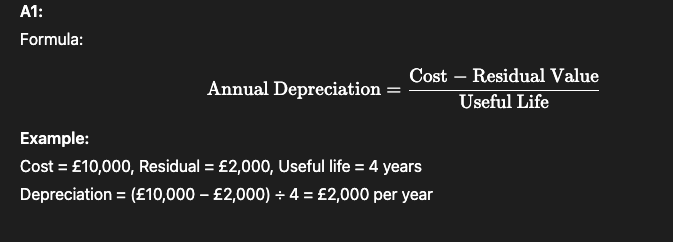
How do you calculate depreciation using the reducing balance method?
Data: Initial carrying amount = £10,000, Depreciation rate = 20%
When is residual value ignored?
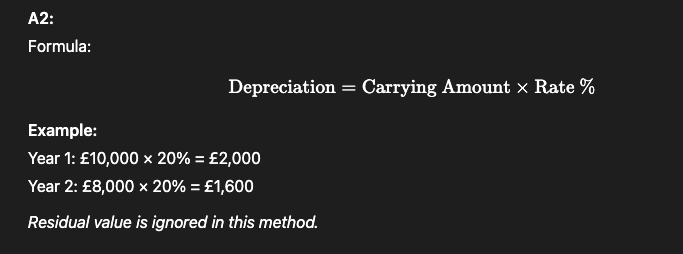
How do you calculate the depreciable amount of an asset?
Data: Cost = £12,000, Residual value = £2,000

How do you calculate Carrying Amount of an asset?
Data: Cost = £25,000, Accumulated depreciation = £6,000, Impairment = £2,000

How do you calculate Gain or Loss on Disposal?
Data: Disposal proceeds = £5,000, Carrying amount = £3,000

How do you calculate Recoverable Amount of an asset?
Data: Fair value = £12,000, Costs to sell = £2,000, Value in use = £9,000

How do you calculate an impairment loss?
Data: Carrying amount = £25,000, Recoverable amount = £18,000

How do you calculate the increase in depreciation after an upward revaluation?
Old carrying amount = £70,000, Revalued amount = £150,000, Remaining life = 5 years
What can be transferred to retained earnings annually?
Extra depreciation = revalued amount-old carrying amount/remaining useful life
🔹 Step 1: Understand the revaluation What’s happening?
The asset was previously worth £70,000, and now it’s been revalued to £150,000.
This is a £80,000 increase in value, but it’s unrealised (you haven’t sold the asset), so it goes into a special equity account called:
Revaluation Surplus
No gain is recognised in profit.
🔹 Step 2: Realise that the asset now has a higher value — so depreciation increases
Because you're now saying the asset is worth more, you need to depreciate more each year.
You are spreading the new, higher value across the remaining life of the asset.
🔹 Step 3: Apply the formula for extra depreciation
We calculate how much additional depreciation results only because of the revaluation:
Extra Depreciation=150,000−70,0005=£16,000 per year\text{Extra Depreciation} = \frac{150,000 − 70,000}{5} = £16,000 \text{ per year}Extra Depreciation=5150,000−70,000=£16,000 per year
So depreciation increases by £16,000 per year.
🔹 Step 4: Why is this not charged to the Profit or Loss (P&L)?
If we charged this extra depreciation to profit, we’d be reducing current year profit —
→ but we never increased profit when the asset went up in value.
That would be unfair.
That £80,000 gain was locked away in Revaluation Surplus, not P&L.
So we don’t reduce profit — instead, we release £16,000/year from Revaluation Surplus into Retained Earnings.
🔹 Step 5: Record the transfer
Journal Entry (annually, if instructed):
nginxCopyEdit
Dr Revaluation Surplus £16,000 Cr Retained Earnings £16,000
This shows: “I’m using up part of the revalued gain now that the asset is being depreciated.”
It's a movement within equity, not an income or expense.
🔹 Step 6: What’s the impact?
Asset’s value is still decreasing through depreciation (like normal)
Revaluation Surplus decreases a little each year
Retained Earnings increases a little each year
Profit stays accurate and isn’t impacted by revaluation effects
✅ Summary of Logic:
Action | Why It Happens |
|---|---|
Revalue asset to £150k | Asset is now worth more — show this on the SOFP |
Depreciation increases | Higher value = higher usage cost over time |
Extra depreciation NOT in P&L | Because revaluation gain wasn’t in P&L either |
Release £16k/year to retained earnings | Recognise that some of the gain is now "earned" |
When an asset is revalued upwards, it creates a revaluation surplus (equity). Over time, this increases depreciation. To prevent that higher depreciation from reducing annual profits (since the gain was never in profit), we subtract the extra depreciation from the revaluation surplus instead. Each year, we move that amount into retained earnings. This reflects that we’ve now “used up” part of the gain, without affecting current profit.

When an asset is revalued upwards, how is the revaluation surplus calculated?
Data: Revalued amount = £120,000, Carrying amount = £70,000
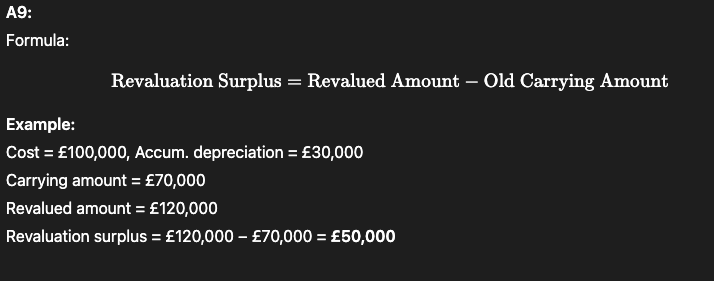
In a downward revaluation (after upward one), how much goes to P&L?
Data: Revaluation surplus = £10,000, New revaluation loss = £15,000
✅ Step-by-Step Logic:
The asset has dropped in value again by £15,000.
You are allowed to offset this against the existing revaluation surplus.
The surplus can only absorb £10,000 of the drop.
The remaining £5,000 is treated as a loss in the P&L.
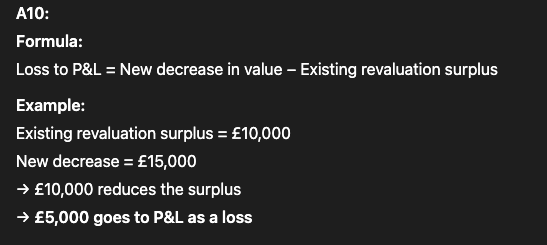
What is the rule for releasing a revaluation surplus on disposal?
A11:
You transfer the entire revaluation surplus related to that asset to Retained Earnings:
Example Entry:
Dr Revaluation Surplus
Cr Retained Earnings
This appears in SOCIE, not in profit or loss.
Chapter 10
What is the formula for revaluation increase (surplus) when an asset under the revaluation model increases in value before being classified as held for sale?
Data:
Carrying amount = $10,000
Fair value = $12,000
Formula:
Revaluation Increase = Fair Value − Carrying Amount
Worked Example:
Fair Value = $12,000
Carrying Amount = $10,000
Revaluation Increase = $12,000 − $10,000 = $2,000
Dr PPE $2,000
Cr Revaluation Surplus $2,000
What is the formula to determine the carrying amount after revaluation, before classifying an asset as held for sale?
Data:
Original carrying amount = $10,000
Revaluation surplus = $2,000
A:
Formula:
Revised Carrying Amount = Original Carrying Amount + Revaluation Surplus
Worked Example:
Original Carrying Amount = $10,000
Revaluation Surplus = $2,000
Revised Carrying Amount = $10,000 + $2,000 = $12,000
🧠 Is the revised carrying amount equal to fair value?
✅ Yes — but only if you’re using the revaluation model under IAS 16.
Here’s how it works:
📘 Under the Revaluation Model (IAS 16):
When an asset is revalued:
🔹 Revised carrying amount = Fair Value at the date of revaluation
So in your example:
The asset had a carrying amount of $10,000
You revalue it to fair value of $12,000
The new carrying amount becomes $12,000
🧾 This is reflected by:
nginxCopyEdit
Dr PPE $2,000 Cr Revaluation Surplus $2,000
❗Important Caveat:
This applies only if you're using the revaluation model.
If you were using the cost model, you wouldn't update the carrying amount to fair value — you'd just stick with original cost minus depreciation.
🔁 Then What?
Once the asset is reclassified as "held for sale" (IFRS 5), you:
Stop depreciating
Measure at lower of:
Carrying amount (which, after revaluation, is fair value)
FVLCTS (Fair value less costs to sell)
So yes — right before classification as held for sale, revised carrying amount = fair value if you're using the revaluation model.
Would you like a quick visual cheat sheet or flowchart for this?
How do you calculate the fair value less costs to sell (FVLCTS) when classifying an asset as held for sale?
Data:
Fair value = $12,000
Costs to sell = $3,000
How are non-current assets held for sale measured?
A:
Formula:
FVLCTS = Fair Value − Costs to Sell
Worked Example:
Fair Value = $12,000
Costs to Sell = $3,000
FVLCTS = $12,000 − $3,000 = $9,000
🔵 Topic: Classification of an Asset as "Held for Sale" (IFRS 5)
When you classify a non-current asset as “held for sale,” this affects two key things:
1. 📏 Measurement 2. 📋 Classification
Let’s walk through each.
✅ 1. MEASUREMENT
When an asset becomes “held for sale,” you stop accounting for it under its usual standard (like IAS 16 for PPE), and instead follow IFRS 5.
🧠 Key Rule:
✔ You must measure the asset at the lower of:
Its carrying amount (book value on the balance sheet)
Its fair value less costs of disposal (i.e. what you’d actually get after selling it)
This is shown visually in the diagram.
Example:
Carrying amount = $12,000
Fair value = $11,000
Costs to sell = $1,500
Fair value less costs = $9,500
Since $9,500 < $12,000, you write the asset down to $9,500
→ The difference is an impairment, which goes to the income statement (SPL)
❌ No Depreciation Anymore
Once the asset is “held for sale” → depreciation stops.
Until that point, you continue depreciating as normal under IAS 16 (for PPE).
✅ 2. PRESENTATION & CLASSIFICATION
Once the asset is “held for sale,” it moves to a new category in your financial statements:
🔷 It is shown as a separate line under current assets
(even though it was a non-current asset before, like PPE or investment property)
This helps users of the accounts clearly see which assets are intended for disposal.
💡 Summary Cheat Sheet:
Concept | What Happens |
|---|---|
Measurement | Value at lower of carrying amount or FVLCTS |
Depreciation | Stops once classified as held for sale |
Impairment | If FVLCTS < carrying amount, record impairment in SPL |
Presentation | Move from non-current to current asset category |
What is the impairment loss formula when revalued assets are written down to fair value less costs to sell under IFRS 5?
Data:
Carrying amount after revaluation = $12,000
FVLCTS = $9,000
Formula:
Impairment Loss = Carrying Amount after Revaluation − FVLCTS
Worked Example:
Carrying Amount after Revaluation = $12,000
FVLCTS = $9,000
Impairment Loss = $12,000 − $9,000 = $3,000
Dr Profit or Loss $3,000
What are the journal entries to transfer a revalued asset to "Held for Sale" at fair value less costs to sell, including impairment?
Original carrying amount = $12,000
Revalued up to fair value = $12,000
Costs to sell = $3,000
Entries (based on the example):
Dr Held for Sale Asset $9,000
Dr Profit or Loss (Impairment) $3,000
Cr PPE $12,000
🔹 1. Dr Held for Sale Asset $9,000
Type: Asset (current asset)
DEAD: A = Asset → DEBIT to increase
📌 You're bringing in a new asset (the reclassified asset held for sale), so you debit it to increase it.
🔹 2. Dr Profit or Loss (Impairment) $3,000
Type: Expense (impairment loss)
DEAD: E = Expense → DEBIT to increase
📌 This is a loss on the asset, so it’s treated as an expense — you debit to reflect the increase in expense (which lowers net income).
🔸 3. Cr PPE $12,000
Type: Asset (non-current)
DEAD: A = Asset → CREDIT to decrease
📌 You’re removing the PPE from the balance sheet, so you credit to reduce the PPE asset.
What happens to the revaluation surplus when the asset is disposed of?
Action:
The Revaluation Surplus is transferred to Retained Earnings upon disposal of the asset.
How are non-current assets held for sale measured?
Formula:
Value at lower of:
Carrying Amount
Fair Value less Costs of Disposal (i.e. selling costs)
If FVLCTS < Carrying Amount → Impairment is charged to profit or loss
Chapter 11
How do you calculate the lease liability at the start of a lease? What payments are included?
Lease payments: $75,000 per year
Term: 4 years (1st payment already made, so 4 payments remain)
Discount rate: 8%
Payments made in arrears (end of each year)
Present Value (Lease Liability) – Summary Workings
Scenario:
Lease payments: $75,000 per year
Term: 4 years (1st payment already made, so 4 payments remain)
Discount rate: 8%
Payments made in arrears (end of each year)
Step 1: Use the present value of annuity formula
PV = Payment × [(1 − (1 + r)^−n) / r]
Step 2: Plug in values
= 75,000 × [(1 − (1.08)^−4) / 0.08]
= 75,000 × [0.265 / 0.08]
= 75,000 × 3.312
Step 3: Calculate
Lease liability = $248,400
This is the present value of the future lease payments and represents the initial lease liability under IFRS 16.
![<p><strong>Present Value (Lease Liability) – Summary Workings</strong></p><p>Scenario:</p><ul><li><p>Lease payments: $75,000 per year</p></li><li><p>Term: 4 years (1st payment already made, so 4 payments remain)</p></li><li><p>Discount rate: 8%</p></li><li><p>Payments made in arrears (end of each year)</p></li></ul><p>Step 1: Use the present value of annuity formula<br>PV = Payment × [(1 − (1 + r)^−n) / r]</p><p>Step 2: Plug in values<br>= 75,000 × [(1 − (1.08)^−4) / 0.08]<br>= 75,000 × [0.265 / 0.08]<br>= 75,000 × 3.312</p><p>Step 3: Calculate<br>Lease liability = $248,400</p><p>This is the present value of the future lease payments and represents the initial lease liability under IFRS 16.</p>](https://knowt-user-attachments.s3.amazonaws.com/ae068145-be66-49c0-acb2-c2d1f3782f83.png)
How do you calculate the lease liability using a discount factor or annuity table?
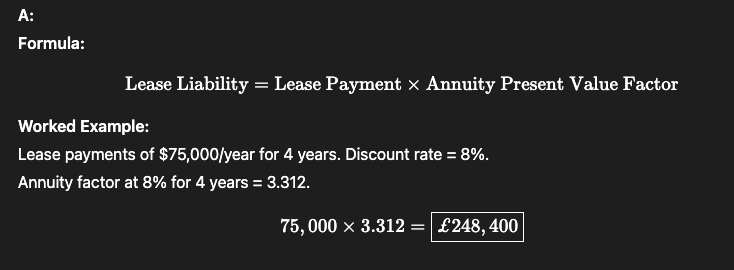
How do you calculate the right-of-use (ROU) asset at lease commencement?
Data: Lease liability = $248,400; initial lease payment = $75,000 (paid in advance); initial direct cost = $1,500

How do you calculate initial recognition?
What is subsequent measurement and how is it calculated for both the lease liability and ROU? use same data as before.
What are the rules for depreciation?
Answer:
At lease commencement, the lessee must recognise:
Lease Liability – measured at the present value of unpaid future lease payments, discounted using the implicit rate (or incremental borrowing rate if unknown).
Right-of-Use (ROU) Asset – measured at:
Lease liability
Lease payments made at or before commencement
Initial direct costs
Estimated dismantling/restoration costs (if applicable)
Subsequent measurement
A. Lease Liability
After initial recognition, the lease liability is:
Increased by interest (unwinding of the discount)
Decreased by lease payments made
Key Formulas:
Interest = Opening Lease Liability × Discount Rate
Principal Repayment = Lease Payment − Interest
Closing Lease Liability = Opening Liability − Principal
Journal Entries:
To record interest:
Dr Finance Cost (P&L)
Cr Lease Liability (SFP)To record lease payment:
Dr Lease Liability
Cr Cash
B. Right-of-Use (ROU) Asset
Measured using the cost model:
ROU Asset = Initial ROU Cost − Accumulated Depreciation − Impairment (if any)
Depreciation Rules:
If ownership transfers at lease end → depreciate over asset's useful life
If ownership does not transfer → depreciate over the shorter of:
Lease term
Asset’s useful life
Depreciation Formula:
Annual Depreciation = ROU Asset ÷ Depreciation Period
Journal Entry:
Dr Depreciation Expense
Cr Accumulated Depreciation
Lease Liability Tables For Payments in Arrears (end of year):
Year | Opening Balance | Interest | Payment | Principal | Closing Balance |
|---|---|---|---|---|---|
1 | X | X | X | X | X |
2 | X | X | X | X | X |
For Payments in Advance (start of year):
Year | Opening Balance | Payment | Subtotal | Interest | Closing Balance |
|---|---|---|---|---|---|
1 | X | (X) | X | X | X |
2 | X | (X) | X | X | X |
📝 Note: For advance payments, year 1’s payment is already made, so it’s excluded from future liability.
Example:
📘 Example Summary (Same as Before)
Lease term: 5 years
Lease payments: $75,000 per year
First payment made on Day 1 (i.e. 1 Dec 20X5) → this is a payment in advance
Discount rate: 8%
PV of remaining 4 payments = $248,400 (→ initial lease liability)
Initial direct cost: $1,500
ROU Asset = 248,400 + 75,000 (first payment) + 1,500 = $324,900
Now let’s work through what happens at the end of Year 1 (31 Dec 20X6).
🔁 Step 1: Lease Liability (Subsequent Measurement)
We use the payments in advance format from the table in your image.
📘 What happens during Year 1:
The first $75,000 payment was made at the start (1 Dec 20X5)
That payment is not part of future payments, so not included in liability at this point
We apply interest on the opening balance of $248,400
🔹 Lease Liability Table (Payments in Advance)
Year | Opening Balance | Payment | Subtotal | Interest (8%) | Closing Balance |
|---|---|---|---|---|---|
1 | $248,400 | (0) | $248,400 | $19,872 | $268,272 |
➡ We haven’t made another payment yet this year (payment is due 1 Dec 20X6), so the liability increases due to interest.
🧾 Journal Entries – Lease Liability (Year 1)
Interest charge:
javaCopyEdit
Dr Finance cost (P&L) 19,872 Cr Lease liability (SFP) 19,872
Payment on 1 Dec 20X6 (Year 2's first day):
nginxCopyEdit
Dr Lease liability 75,000 Cr Cash 75,000
🟩 Step 2: Right-of-Use (ROU) Asset – Depreciation
We use the cost model (initial cost – depreciation – impairment).
📘 Depreciation period?
Ownership does not transfer at lease end
So: Depreciate over shorter of lease term or useful life = 5 years
🔹 Annual Depreciation: 324,900÷5 = 64,980 per year
🧾 Journal Entry – ROU Asset (Depreciation for Year 1)
nginxCopyEdit
Dr Depreciation expense 64,980 Cr Accumulated depreciation 64,980
✅ End of Year 1 Snapshot
Component | Value | Notes |
|---|---|---|
Lease liability | $268,272 | After adding interest |
ROU asset | $324,900 – $64,980 = $259,920 | After 1 year of depreciation |
Profit or loss | $64,980 depreciation + $19,872 interest = $84,852 expense |
✅ End of Year 2 Snapshot (Continuing Sadio’s Example) Recap:
Lease term: 5 years
Annual lease payment: $75,000
Discount rate: 8%
First payment made in advance (1 Dec 20X5)
Lease liability at end of Year 1: $268,272
Second payment made on 1 Dec 20X6 (start of Year 2)
Lease Liability – Year 2:
Opening balance: $268,272
Less: Payment on 1 Dec 20X6: ($75,000)
Subtotal: $193,272
Add: Interest at 8%: $15,462
Closing balance: $208,734
ROU Asset – Year 2:
Opening value (after Year 1): $259,920
Less: Depreciation for Year 2: ($64,980)
Closing value: $194,940
Profit or Loss – Year 2:
Depreciation: $64,980
Interest: $15,462
Total expense in P&L: $80,442
📋 End of Year 2 Summary Table:
Component | Value | Notes |
|---|---|---|
Lease liability | $208,734 | After interest and payment |
ROU asset | $194,940 | After 2 years of depreciation |
Profit or loss | $80,442 | Includes depreciation and interest |
✅ Example: Lease Payments in Arrears (Simple Case)
Let’s walk through a 3-year lease paid in arrears (i.e. at the end of each year).
Scenario:
Lease term: 3 years
Lease payment: $10,000 per year
Discount rate: 5%
Payments made at end of each year
No upfront payments or fees
Initial Recognition:
Calculate the present value of lease payments:
PV = 10,000 / 1.05^1 + 10,000 / 1.05^2 + 10,000 / 1.05^3
= 9,524 + 9,070 + 8,638 = $27,232
Initial lease liability = $27,232
ROU asset = $27,232
Depreciation = $9,077.33 per year
Lease Liability Tables:
Year 1:
Opening: $27,232
Interest: $1,362
Payment: $10,000
Principal: $8,638
Closing: $18,594
Year 2:
Opening: $18,594
Interest: $930
Payment: $10,000
Principal: $9,070
Closing: $9,524
Year 3:
Opening: $9,524
Interest: $476
Payment: $10,000
Principal: $9,524
Closing: $0
Summary:
Lease liability reduces to zero over 3 years
Interest is expensed each year
Lease payments made at the end of each year
Depreciation = $9,077.33 per year
✅ What Does the Principal Column Show?
The principal column shows the portion of the lease payment that reduces the lease liability.
Every lease payment is split into:
Component | What it does |
|---|---|
Interest | Expense recognised in P&L (finance cost) |
Principal | Reduces the lease liability (the debt owed) |
Formula:
Principal = Lease Payment − Interest
Example (Year 1 from above):
Lease payment = $10,000
Interest = $1,362
Principal = $10,000 − $1,362 = $8,638
So:
$1,362 → recorded in P&L
$8,638 → reduces lease liability on balance sheet
Final Takeaway:
The principal portion is how much of the lease payment you're actually “paying off” — like repaying a loan. Interest is just the cost of borrowing.
🧠 Summary
Subsequent measurement includes:
Interest charge each year → increases lease liability
Lease payments → reduce liability
Depreciation on ROU asset
Balance sheet split:
Lease liability = current + non-current
ROU asset = cost – accumulated depreciation
How do you calculate the annual depreciation on the ROU asset?
Data: ROU asset = $27,232; Lease term = 3 years; ownership does not transfer
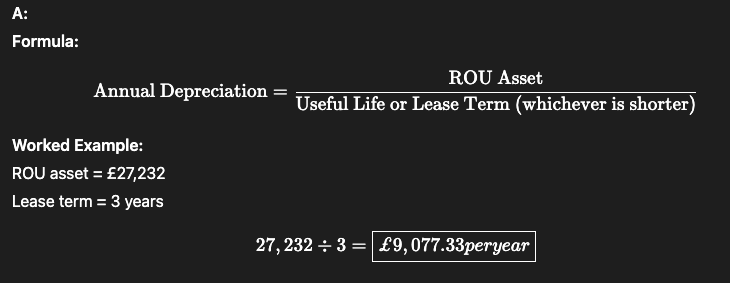
How do you calculate the interest charge on the lease liability each year?
Lease liability at start of year: £27,232
Interest rate 5%
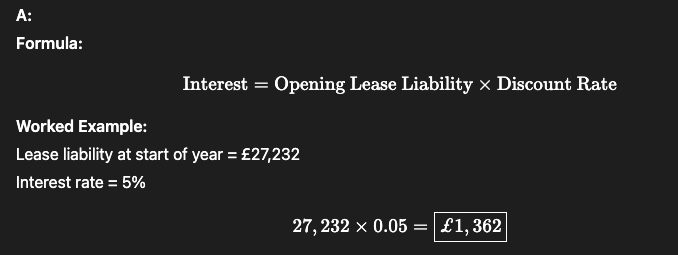
How do you split a lease payment between interest and principal?
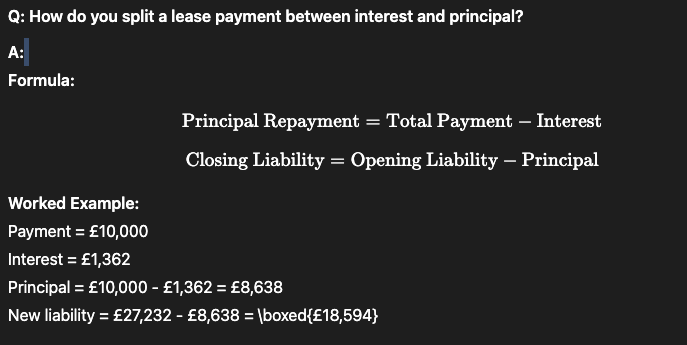
How do you calculate the lease expense for a low-value or short-term lease under the simplified approach?
Formula:
Lease Expense per Year = Total Lease Payments ÷ Lease Term in Years
Worked Example:
Total lease payments = $5,000 (including deposit and rent)
Lease term = 4 years
Lease Expense = $5,000 ÷ 4 = $1,250 per year
How do you calculate the prepayment shown on the balance sheet under the simplified approach?
A:
Formula:
Prepayment (Current Asset) = Cash Paid − Expense Charged to P&L
Worked Example:
Cash paid in Year 1 = $2,000
Lease expense for Year 1 = $1,250
Prepayment = $2,000 − $1,250 = $750
✅ What is a Prepayment on the Balance Sheet?
A prepayment is a payment made in advance for goods or services that will be received in future periods. Until those services are "used up," the payment is treated as an asset, not an expense.
🧾 In IFRS 16 Context:
If a lease payment is made before the related lease period starts, the amount is recorded as a prepayment (a current asset), not as an expense.
📘 Example:
Total lease cost: $5,000 over 4 years
Annual lease expense = $1,250 (5,000 ÷ 4)
Cash paid in Year 1: $2,000 (deposit + first year payment)
In Year 1:
P&L expense = $1,250
Excess paid = $2,000 − $1,250 = $750
Balance Sheet:
Show $750 as a prepayment (current asset)
📦 Why It's an Asset:
You’ve paid for a benefit you haven’t yet received — so until it’s “used,” it sits on the balance sheet as a future economic benefit.
✅ Summary:
When Paid | What Happens |
|---|---|
Before the period | Record as prepayment (asset) |
During the period | Allocate as expense in P&L |
How do you calculate the total lease expense for the year under the accruals concept (low-value lease)?
A:
Formula:
Lease Expense = Total Rentals Payable ÷ Total Lease Period
Worked Example:
Total rentals = $5,000
Lease period = 4 years
Lease Expense = $5,000 ÷ 4 = $1,250 per year
Chapter 12
What is the formula for calculating the value of inventory using the FIFO method? Include when it's used.
During the first four days of June, Tyrone made the following inventory transactions:
Day 1: Purchase 200 units @ $15
Day 2: Purchase 100 units @ $18
Day 3: Sale of 250 units (ignore selling price)
Day 4: Purchase 150 units @ $20
There was no opening inventory.
A1:
FIFO (First In, First Out) assumes the oldest inventory is sold first.
Formula:
Closing inventory = Total purchases – Sales
Then value the remaining (newest) units using most recent purchase prices.
Example:
Purchases: 200 units @ $15, 100 units @ $18, 150 units @ $20
Sales: 250 units
Closing inventory = 200 + 100 + 150 – 250 = 200 units
Use most recent purchases:150 × $20 = $3,000
50 × $18 = $900
Total = $3,900
How do you calculate the value of closing inventory using the periodic AVCO method? Use the following scenario:
During the first four days of June, Tyrone made the following inventory transactions:
Day 1: Purchase 200 units @ $15
Day 2: Purchase 100 units @ $18
Day 3: Sale of 250 units (ignore selling price)
Day 4: Purchase 150 units @ $20
There was no opening inventory.
Required:
Using the periodic AVCO method, calculate the value of closing inventory at the end of Day 4.
A2:
AVCO (Average Cost) assumes all inventory is valued at a weighted average cost.
Step 1: Add up all purchases
200 × $15 = $3,000
100 × $18 = $1,800
150 × $20 = $3,000
Total cost = $7,800
Total units = 200 + 100 + 150 = 450 units
Step 2: Calculate Weighted Average Cost per unit
$7,800 ÷ 450 = $17.33
Step 3: Calculate Closing Inventory
250 units were sold → 450 – 250 = 200 units remain
200 × $17.33 = $3,467
How do you calculate Net Realisable Value (NRV) for inventory?
How is inventory valued? At the lower of…
A3:
NRV = Estimated Selling Price – Costs to Complete – Costs to Sell
Example:
Selling price = $18,000
Cost to complete = $4,200 (only $2,100 borne by entity)
NRV = $18,000 – $2,100 = $15,900
📘 IAS 2 — Inventory Valuation Rule
Inventory must be valued at the lower of:
Cost, and
Net Realisable Value (NRV)
✅ Cost = What it took to bring the item to its current state/location
Purchase price
Conversion costs (e.g. labour, overheads)
Freight and handling (if applicable)
✅ NRV = The amount you expect to sell it for
NRV = Selling Price – Costs to Complete – Costs to Sell
🧠 Why “Lower of”?
This is a conservative accounting principle:
If inventory is worth less than what it cost, we must record the loss immediately
We don’t overstate assets or profits
📦 So, how do you determine “Cost”?
When it’s hard to track the actual cost of each item (e.g. identical units bought at different prices), IAS 2 allows reasonable approximations:
🔁 Reasonable Cost Approximations (Approved by IAS 2): 1⃣ FIFO (First-In, First-Out)
Assumes the oldest inventory is sold first
Closing inventory = newest purchases
Appropriate when stock rotates (e.g. perishables like food)
2⃣ AVCO (Average Cost Method)
All inventory units are assigned the same weighted average cost
Appropriate when items are indistinguishable (e.g. oil, grains)
🔗 How It All Fits Together:
Choose a method (FIFO or AVCO) to estimate the cost of inventory
Compare that cost to NRV
Value inventory at the lower of the two
✅ Example:
FIFO Cost of closing inventory = $3,900
AVCO Cost of closing inventory = $3,467
NRV = $3,500
Final inventory valuation =
Under FIFO: $3,500 (lower than $3,900)
Under AVCO: $3,467 (lower than NRV, so use $3,467)
How do you value inventory under IAS 2 when NRV is lower than cost?
A4:
Inventory is valued at the lower of cost and NRV.
Example:
Inventory cost = $16,800
NRV = $15,900
→ Value = $15,900
What is a replacement cost?
Under IAS 2, if the replacement cost of materials falls after purchase, how should inventory be valued?
Include how this interacts with the ‘lower of cost and NRV’ rule. How about for the reverse?
Replacement cost is the amount it would currently cost to repurchase the same materials.
Under IAS 2, replacement cost is not used directly to value inventory. Instead, inventory is valued at the lower of original cost and Net Realisable Value (NRV).
A drop in replacement cost may suggest NRV has fallen, but you only reduce the inventory value if NRV < cost.
Example:
Original cost = $12,000
Replacement cost = $10,000
If NRV is still above $12,000 → value remains at $12,000.
Under IAS 2, inventory should be valued at the lower of original cost and NRV (Net Realisable Value) — not replacement cost.
A fall in replacement cost does not affect inventory valuation unless it indicates that NRV has fallen below original cost.
Example:
Original cost = $12,000
Replacement cost = $10,000 (lower, but irrelevant unless NRV is also low)
If the inventory is still for a profitable order → NRV > $12,000
✅ Therefore, value at $12,000Reversed
Under IAS 2, if NRV falls below the original cost, inventory must be valued at NRV. This applies even if the materials were originally bought at a higher cost.
Example:
Original cost = $12,000
NRV = $10,000 (due to fall in selling price or damage)
✅ Since NRV < cost, value the inventory at $10,000
This ensures the inventory is not overstated on the balance sheet and reflects expected future economic benefit.
How is inventory valued under the AVCO method using rolling updates (perpetual method)? Use the following data to calculate closing inventory value:
Day 1: Purchase 200 units @ $15
Day 2: Purchase 100 units @ $18
Day 3: Sale of 250 units
Day 4: Purchase 150 units @ $20
There was no opening inventory.
Under the perpetual AVCO method, you recalculate the average cost after each purchase. This new average is used to value any subsequent sales.
🧮 Step-by-step calculation:
Day 1:
Purchase 200 @ $15 = $3,000
→ Avg. cost = $15
Day 2:
Purchase 100 @ $18 = $1,800
New average cost = ($3,000 + $1,800) ÷ (200 + 100)
→ $4,800 ÷ 300 = $16 per unit
Day 3:
Sell 250 units @ $16
→ COGS = 250 × $16 = $4,000
→ Inventory left = 50 units × $16 = $800
Day 4:
Purchase 150 @ $20 = $3,000
New average cost = ($800 + $3,000) ÷ (50 + 150)
→ $3,800 ÷ 200 = $19 per unit
Chapter 13
How do you calculate cash received from customers using the direct method?
Data:
Sales = 444, Opening receivables = 42, Closing receivables = 48
Formula:
Cash received = Sales revenue + Opening receivables – Closing receivables
Calculation:
Cash received = 444 + 42 – 48 = 438
Explanation:
This formula adjusts sales revenue to reflect the actual cash collected.
If receivables increase, it means some customers haven’t paid yet (less cash in).
If receivables decrease, it means more was collected than earned in the period.
How do you calculate cash paid to suppliers using the direct method?
Data:
Cost of materials used = 222
Opening inventory = 24, Closing inventory = 42
Opening payables = 18, Closing payables = 30
Step 1 – Calculate Purchases:
Purchases = Materials used + Closing inventory – Opening inventory
= 222 + 42 – 24 = 240
Step 2 – Cash paid to suppliers:
= Purchases + Opening payables – Closing payables
= 240 + 18 – 30 = 228
Explanation:
Purchases show what was bought, but payables adjust for timing of cash payments.
If payables increase, you paid less (cash out goes down).
If payables decrease, you paid more (cash out goes up).
What is the formula for cash generated from operations (Indirect Method)?
What is the formula for cash generated from investing activities?
What is the formula for cash generated from financing activities?
Operations
Profit before tax
Depreciation
Loss on disposal
– Profit on disposalFinance costs
– Investment/rental income
± Changes in inventories, receivables, and payables
Example:
Profit before tax = 114
Depreciation = 84
– Profit on disposal = (60)Finance costs = 18
– Increase in inventories = (18)
– Increase in receivables = (6)Increase in payables = 12
Cash from operations = 144
Investments
Purchase of PPE (-)
Purchase of Investments (-)
Proceeds from sale of PPE (+)
Proceeds from sale of investments (+)
Interest received (+)
Dividends received (+)
Financing
Proceeds from issue of ordinary shares (+)
Proceeds from issue of preference shares (+)
Proceeds from long-term borrowings (+)
Dividends paid (-)
Redemption of long term borrowings (-)
How do you calculate interest paid using a T-account?
Finance cost = 18, Opening = 4, Closing = 6
Formula:
Interest paid = Finance cost (P&L) + Opening payable – Closing payable
Example:
Finance cost = 18, Opening = 4, Closing = 6
Interest paid = 18 + 4 – 6 = 16
How do you calculate interest/dividends received (Investing Activities)?
Interest income = 8, Opening = 2, Closing = 1
Formula:
Cash received = P&L amount + Opening receivable – Closing receivable
Example:
Interest income = 8, Opening = 2, Closing = 1
Cash received = 8 + 2 – 1 = 9
P&L income = 8,000, Opening receivable = 2,000, Closing receivable = 1,000
Entries:
Dr Bank 9,000 → cash actually received
Cr Interest Receivable 1,000 → reduced the receivable (asset down)
Cr P&L (Interest income) 8,000 → recognise the full income earned
Why:
You earned £8k, but only £9k came in because you also collected £1k that was owed from before.
How do you calculate cash paid for non-current assets?
Opening = 100, Disposal = 10, Depreciation = 20, Closing = 140
Formula:
Use carrying amount T-account:
Cash paid (additions) = Balancing figure
Example:
Opening = 100, Disposal = 10, Depreciation = 20, Closing = 140
Right side = 10 + 20 + 140 = 170
Left side = 100 + Additions
Additions = 170 – 100 = 70
Balancing figure from asset T-account.
Entries:
Dr Non-Current Asset 70,000 → asset increased
Cr Bank 70,000 → cash paid out
Why:
You're spending money to buy an asset — cash goes down, assets go up.
How do you calculate cash received on disposal of non-current assets? What are the step by step journal entries?
Cost = 40, Acc. dep = 30, Profit = 5
Carrying amount = 10
Formula:
Cash received = Carrying amount ± Profit/Loss on disposal
Where: Carrying amount = Cost – Acc. depreciation
Example:
Cost = 40, Acc. dep = 30, Profit = 5
Carrying amount = 10
Cash received = 10 + 5 = 15
Cost = 40,000, Accumulated depreciation = 30,000, Profit = 5,000
Step-by-step entries:
Remove original asset:
Dr Disposal Account 40,000
Cr Non-Current Asset 40,000
Remove depreciation:
Dr Accumulated Depreciation 30,000
Cr Disposal Account 30,000
Record cash received:
Dr Bank 15,000
Cr Disposal Account 15,000
Record profit on sale:
Dr Disposal Account 5,000
Cr P&L (Gain) 5,000
What is the formula to calculate proceeds from new share issues?
A:
Formula:
Proceeds = (Closing share capital + premium) – (Opening share capital + premium)
Example:
Closing = 140, Opening = 100
Proceeds = 140 – 100 = 40
Share capital + premium increased by 40,000.
Entries:
Dr Bank 40,000 → cash received
Cr Share Capital and Premium 40,000 → equity increased
Why:
You issued new shares and received cash — equity and bank both increase.
What is the formula to calculate loan proceeds?
Closing = 90, Repayment = 10, Opening = 50
A:
Formula:
Proceeds = Closing loan + Repayment – Opening loan
Example:
Closing = 90, Repayment = 10, Opening = 50
Proceeds = 90 + 10 – 50 = 50
Opening loan = 50k, closing loan = 90k, repayment = 10k → proceeds = 50k
Entries:
Dr Bank 50,000 → cash received
Cr Loan Payable 50,000 → liability increased
Why:
You're borrowing money — cash increases, but so does what you owe.
What is the formula to calculate loan repayments?
Opening = 60, Proceeds = 40, Closing = 70
Formula:
Repayment = Opening loan + Proceeds – Closing loan
Example:
Opening = 60, Proceeds = 40, Closing = 70
Repayment = 60 + 40 – 70 = 30
Opening loan = 60k, Proceeds = 40k, Closing = 70k → repayment = 30k
Entries:
Dr Loan Payable 30,000 → reduce liability
Cr Bank 30,000 → cash out
Why:
You paid off part of a loan — cash decreases, and your liability decreases.
What is the formula to calculate dividends paid using retained earnings?
Opening = 120, Profit = 72, Closing = 170
Formula:
Dividends paid = Opening retained earnings + Profit – Closing retained earnings
Example:
Opening = 120, Profit = 72, Closing = 170
Dividends = 120 + 72 – 170 = 22
Opening RE = 120k, Profit = 72k, Closing = 170k → dividend = 22k
Entries:
Dr Retained Earnings 22,000 → reduce equity
Cr Bank 22,000 → cash paid out
Why:
Paying dividends reduces both retained profits and cash.
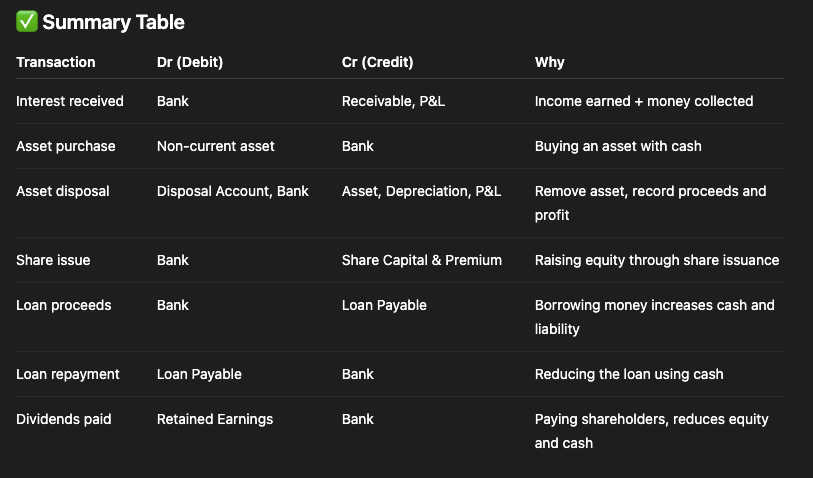
What is the formula to calculate interest earned on a deposit or savings account over a specific time period? Include any useful assumptions.
Deposit = £10,000
Interest rate = 5% per annum
Period = 90 days
Day count = 365
Formula:
Interest = (Amount deposited × Annual interest rate × Number of days interest earned) / Annual day count
Assumptions:
UK interest typically uses 365 days/year
US dollar interest in money markets uses 360 days/year
Example:
Deposit = £10,000
Interest rate = 5% per annum
Period = 90 days
Day count = 365
Interest = (10,000 × 0.05 × 90) / 365 = £123.29
How do you calculate the return from a Treasury Bill bought at a discount?
Face value = £10,000
Purchase price = £9,900
Formula:
Return = Face value – Purchase price
Example:
Face value = £10,000
Purchase price = £9,900
Return = £10,000 – £9,900 = £100
How do you calculate the interest yield (return as a percentage) on a Treasury Bill or similar discount instrument?
Example:
Face value = £10,000
Purchase price = £9,900
Days to maturity = 91
Formula:
Yield (%) = [(Face value – Purchase price) / Purchase price] × (365 / Number of days to maturity) × 100
Example:
Face value = £10,000
Purchase price = £9,900
Days to maturity = 91
Yield = [(10,000 – 9,900) / 9,900] × (365 / 91) × 100
Yield ≈ 0.0101 × 4.0109 × 100 ≈ 4.05%
How do you calculate interest income from a Certificate of Deposit (CD) if held to maturity?
Example:
Principal = £50,000
Interest rate = 4%
Term = 180 days
Day count = 365
Formula:
Interest = Principal × Annual interest rate × (Term in days / Annual day count)
Example:
Principal = £50,000
Interest rate = 4%
Term = 180 days
Day count = 365
Interest = £50,000 × 0.04 × (180 / 365) = £986.30
How do you calculate the return from selling a negotiable CD or bill of exchange in the secondary market?
Example:
Purchase price = £99,500
Selling price = £100,200
Formula:
Return = Selling price – Purchase price
Example:
Purchase price = £99,500
Selling price = £100,200
Return = £100,200 – £99,500 = £700
How is the effective yield on a bill of exchange or commercial paper calculated when sold at a discount?
Example:
Face value = £100,000
Discounted price = £98,500
Maturity = 90 days
A:
Formula:
Yield (%) = [(Face value – Discounted price) / Discounted price] × (360 / Days to maturity) × 100
Example:
Face value = £100,000
Discounted price = £98,500
Maturity = 90 days
Yield = [(100,000 – 98,500) / 98,500] × (360 / 90) × 100
= 0.0152 × 4 × 100 ≈ 6.08%
Chapter 15
What is the formula for the Working Capital Cycle (manufacturing business)? Include all components.
Working Capital Cycle =
Raw Materials Holding Period
Work-in-Progress (WIP) Holding Period
Finished Goods Holding Period
Receivables Collection Period
− Payables Payment Period
Example:
Raw Materials = 40 days
WIP = 15 days
Finished Goods = 30 days
Receivables = 35 days
Payables = 25 days
Working Capital Cycle = 40 + 15 + 30 + 35 − 25 = 95 days
What is the simplified Working Capital Cycle formula for a retail or wholesale business?
Working Capital Cycle =
Inventory Holding Period
Receivables Collection Period
− Payables Payment Period
Example:
Inventory = 50 days
Receivables = 20 days
Payables = 30 days
Cycle = 50 + 20 − 30 = 40 days
What is the formula for Raw Material Inventory Holding Period?

What is the formula for WIP Holding Period?
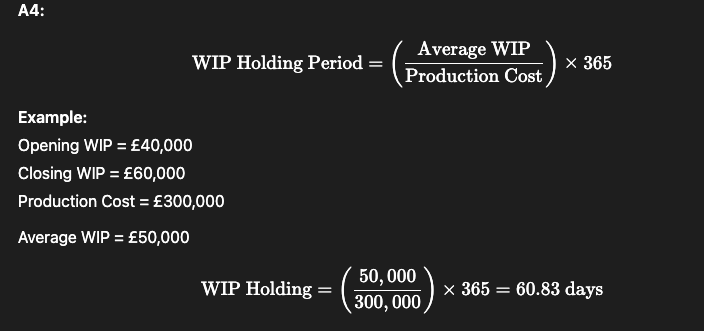
What is the formula for Finished Goods Holding Period?
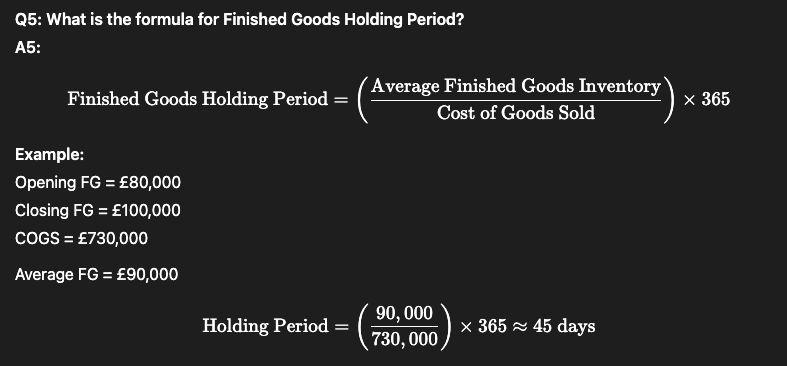
What is the formula for Inventory Turnover (number of times)?
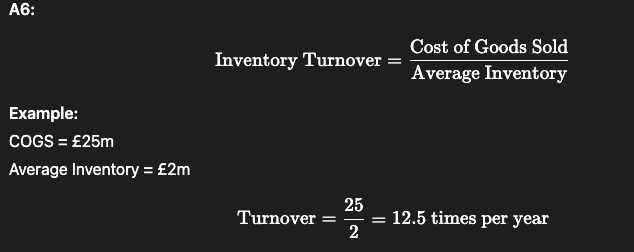
How do you convert an Inventory Turnover Ratio into a Holding Period?
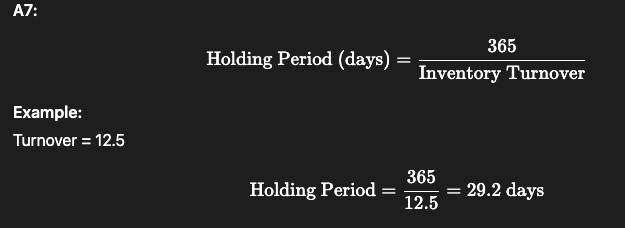
What is the formula for Receivables (Trade Debtors) Collection Period?
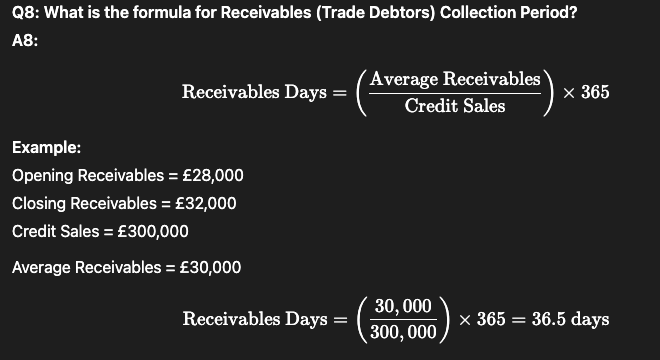
What is the formula for Payables (Trade Creditors) Payment Period?
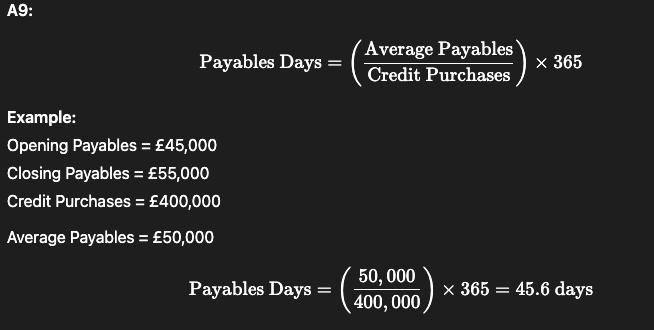
How do you estimate any inventory-related holding period when detailed usage figures aren’t available?
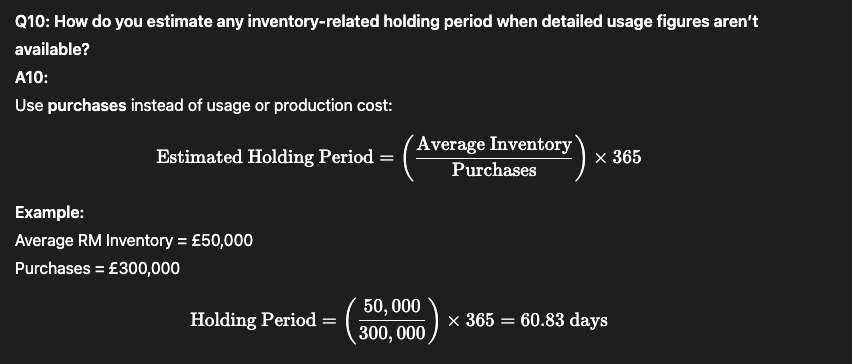
Chapter 16
How do you calculate the receivable balance using receivable days?
A:
Formula:
Receivable balance = (Sales × Receivable days) ÷ 365
Example:
Sales = £5,000,000
Receivable days = 60
Receivable balance = (5,000,000 × 60) ÷ 365 = £821,918
How do you calculate the annual finance cost of receivables using an overdraft rate?
A:
Formula:
Finance cost = Receivable balance × Overdraft interest rate
Example:
Receivable balance = £821,918
Interest rate = 10%
Finance cost = 821,918 × 10% = £82,192